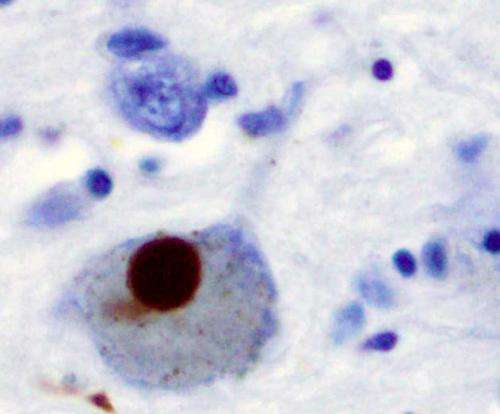New strategy reduces side effects in Parkinson's treatment

In an international study, Northwestern Medicine scientists and colleagues have identified a novel strategy for reducing the side effects of uncontrolled movement caused by the drug levodopa, commonly used to treat the stiffness, tremors and poor muscle control of Parkinson's disease.
These unwanted movements caused by levodopa significantly diminish the quality of life for Parkinson's disease patients.
A team lead by D. James Surmeier found neurons in the brain responsible for the side effects have a distinctive surface receptor that normally helps balance the effects of levodopa treatment. When mouse or primate models of Parkinson's disease were given a compound that boosts functioning of this receptor, the uncontrolled motor side effects of levodopa treatment were dramatically reduced.
Surmeier is the Nathan Smith Davis Professor and chair of physiology at Northwestern University Feinberg School of Medicine.
The study will be published Nov. 18 in the journal Neuron.
Although this new compound—an M4 muscarinic receptor positive allosteric modulator—is not currently approved for human use, it is in development with the goal of clinical trials, a Phase I trial possibly starting by 2017.
"There has been an international effort to find a drug that can be combined with levodopa to reduce the uncontrolled movement," Surmeier said. "If clinical trials confirm our preliminary findings, the eventual drug developed could make a significant improvement in the quality of life for people with Parkinson's disease."
Parkinson's is the second most common neurodegenerative disease in the U.S., affecting more than a million people, a number expected to double by 2030. In its early stages, the primary symptom of the disease—difficulty moving—can be effectively treated by levodopa.
But as the disease progresses, the dose of levodopa required to alleviate symptoms rises and side effects begin to appear. The most prominent of these is uncontrolled movement or dyskinesia. There are no treatment strategies that can help other than neurosurgery.
Surmeier's effort was built upon previous work of his lab and other research exploring the striatum, a part of the brain circuitry targeted by levodopa and thought to drive dyskinesia. At doses of levodopa treatment that produce dyskinesia, part of the striatal network becomes abnormally re-wired.
Surmeier's team found a protein in one type of these striatal neurons that could counter-balance the effects of levodopa without diminishing its positive effect on movement. By using a novel class of drug—one that augments the normal function of the receptor—scientists could boost function of this 'balancing' M4 muscarinic receptor. This novel compound or drug lead was developed by the group of Jeffrey Conn at Vanderbilt University in Nashville, Tennessee.
While all of the studies in Surmeier's lab and that of his collaborator Dr. Angela Cenci Nilsson of Lund University in Sweden, were conducted in mice, scientists wanted to make sure they were relevant to humans. To test the effects in non-human primates, Dr. Erwan Bezard's group in Bordeaux, France, gave a variant of the compound tested in mice to Parkinsonian primates. As in the mice, the novel compound significantly reduced dyskinesia induced by levodopa treatment without compromising its symptomatic benefit.
More information: "M4 muscarinic receptor signaling ameliorates striatal plasticity deficits in models of L-DOPA-induced dyskinesia," Neuron, 2015.

















